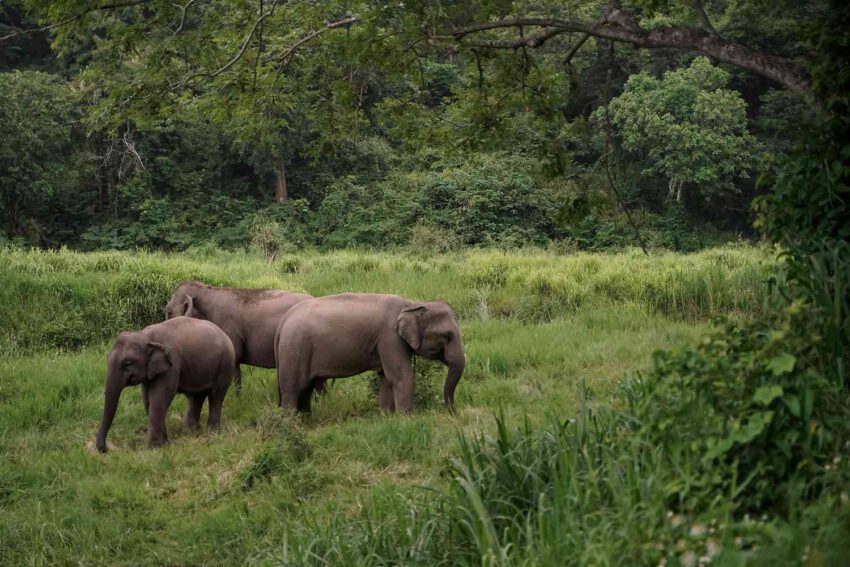In Thailand, it’s very easy to encounter an elephant. Some sites allow quiet observation, as you admire the massive animals from afar. Other tourist venues offer activities like feeding, riding, or bathing with elephants. Many places toss around the term “ethical” when describing the encounters, but they often are not the sanctuaries they promote.
“Visiting an animal sanctuary while traveling can be a great way to support local animal welfare and conservation efforts, but you need to do your homework because there are many bogus sanctuaries operating that can lure in well-meaning and unsuspecting tourists,” Wendy Higgins, director of international media for Humane Society International, told Travel + Leisure.
An immediate red flag is if visitors can participate in any hands-on interactions with elephants such as playing with babies or taking elephant rides. Another warning sign is if the elephants perform in shows or demonstrations, like painting, Higgins said. “These are entirely unnatural displays for which the elephants will be forced to train, and there is no welfare benefit to the elephant whatsoever. A true sanctuary will never encourage or force any animal to interact with people, especially tourists.”
:max_bytes(150000):strip_icc()/TAL-riding-ran-tong-elephant-sanctuary-thailand-THAIELLES0124-390b29415acb4d5ea5ecbd8247ea3533.jpg)
Westend61/Getty Images
Elephant tourism has been an important part of Thailand’s economy for five decades. There are about 4,000 wild elephants in Thailand, reports the World Wildlife Fund (WWF) with an additional 3,800 elephants in captivity. The country is home to three-quarters of the captive elephants in Asia with a 70 percent increase in just a decade, according to a 2020 report from the non-profit World Animal Protection. Of the venues studied across Asia, the report found that 63 percent of elephants live in dire conditions at 208 locations and only 7 percent of elephants were kept in “high welfare” venues.
“When travelers visit Asia, particularly places like Thailand, they are focused on captive elephants because of opportunities to interact with them,” Nilanga Jayasinghe, a wildlife conservation manager at WWF, told T+L. “However, it’s important to remember that there are also wild elephants in these places, and they are facing significant conservation challenges. There is direct value in keeping these elephants wild, living as elephants should live.”
Asian elephants are classified as endangered with their numbers decreasing by the International Union for Conservation of Nature (IUC) Red List, which tracks the conservation status and extinction risk of species. They have been threatened by conflict with humans, poaching, and illegal elephant trade. The main threat is habitat loss and fragmentation — where parts of their habitat are destroyed, leaving smaller, disconnected areas. “They live on the most populous continent on the planet alongside a burgeoning human population, so habitat loss is a significant threat,” said Jayasinghe.
Wendy Higgins
Unethical elephant facilities attract tourists because people love elephants and are delighted at the possibility of getting up close and personal. What they won’t necessarily know is that the elephants are not willing participants in that encounter, and can suffer greatly for the tourist trade.
In Thailand, captive elephants are classified as “beasts of burden” with few welfare protections. Thailand’s Cruelty Prevention and Welfare of Animals Act of 2014 was enacted to prevent animal cruelty and promote welfare but, until recently, there was little enforcement and little motivation to improve conditions.
Now, the livestock ministry, which has jurisdiction over captive elephants, is working to develop welfare standards and legal penalties to enforce the law, reports the Asian Elephant Specialist Group, a global network of specialists studying and monitoring the conservation of Asian elephants. And a Thailand-based independent welfare organization is performing welfare audits of tourist camps.
How to Tell if a Sanctuary Is Ethical
“As a general rule, a true sanctuary will allow you to look but not touch the elephants,” said Higgins. “A sanctuary will allow you to see elephants just being elephants in as near a wild setting as possible, and the tourist is a mere observer.”
Another pro-tip: research what is offered at an elephant tourist location and look at photos before visiting. These are some telltale signs that sanctuaries are not ethical:
- Elephants are restrained, particularly chained by the foot.
- Workers carry bullhooks. These are long poles with sharp hooks on the ends that have been used to control elephants.
- The location offers elephant rides, elephant painting, or other interactive experiences, like feeding the elephants.
- They engage in captive breeding to always have baby elephants on hand for tourists to pet or feed.
:max_bytes(150000):strip_icc()/TAL-feeding-elephants-sanctuary-krabi-thailand-THAIELLES0124-be62a0fcaf3d40ff84abec68b32e66f7.jpg)
Westend61/Getty Images
“Unethical elephant facilities attract tourists because people love elephants and are delighted at the possibility of getting up close and personal. What they won’t necessarily know is that the elephants are not willing participants in that encounter, and can suffer greatly for the tourist trade,” said Higgins.
“Visiting these establishments perpetuates a cycle of animal suffering in which the animals experience boredom, frustration, and even physical pain or fear. These places can also pose a danger to the human visitors in some cases because elephants are very large powerful animals whose behavior can be unpredictable in an overcrowded or stressful situation.”
If you choose to visit a genuine elephant sanctuary, look for ones that give back to practical and local conservation efforts, Higgins suggested. “By supporting those sanctuaries that are doing things right, and promoting your visit on social media with a reminder that you chose it for its ethical practices, it’s a great way to encourage other travelers to do the right thing too.”
The WWF suggested visiting places like Kui Buri, Khao Yai, or Kaeng Krachan national parks where you can see elephants in the wild.
“It’s a much more enriching experience to go see them in the wild if you are visiting a country like Thailand, where you can experience them in all their majesty,” said WWF’s Jayasinghe. “You don’t have to touch or bathe an elephant to experience how amazing they are.”
